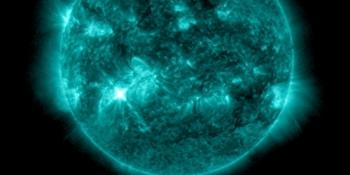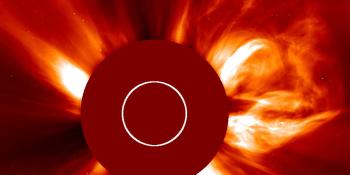Przeglądasz Archiwum z środa, 24 sierpnia 2005
Raport aktywności słonecznej
Każdy wspomniany rozbłysk słoneczny w tym raporcie ma współczynnik skalowania dodany przez Space Weather Prediction Center (SWPC). Przez skale współczynników SWPC, raporty o rozbłyskach słonecznych są o 42% mniejsze niż naukowo jakościowa data. Skale współczynników zostały usunięte z naszych archiwów o rozbłyskach słonecznych by odzwierciedlić prawdziwe jednostki fizyczne.
Raport aktywności słoneczno- geomagnetycznej 2005 Aug 24 2203 UTCPrzygotowane przez NOAA © SWPC i przetworzone przez SpaceWeatherLive.com
Połączenie raportów USAF/NOAA o słonecznej i geofizycznej aktywności
Numer SDF 236 wydany w 2200Z na 24 Aug 2005IA. Analiza aktywności regionów słonecznych i aktywność od 23-2100Z do 24-2100Z Solar activity was low during the past 24 hours.
Today's activity consisted of a few C-class events. The largest was
a C4 at 0706 UTC from Region 798 (S11W90) which is rotating off the
visible disk. Region 800 (N17W21) and newly numbered Region 803
(N12E78) also contributed to the activity. New Region 802 (S12E14)
emerged on the disk today as a small, simple H-type group.
IB. Prognoza aktywności słonecznej
Solar activity is expected to be
mostly low, but there is a fair chance for an isolated M-class event
from Region 798 during the next 24 hours (25 August). Probabilities
will decline for 26-27 August but there will still be a slight
chance for an isolated M-class event from Region 800 or Region 803.
IIA. Podsumowanie aktywności geofizycznej 23-2100Z do 24-2100Z
The geomagnetic field ranged from quiet to severe storm levels. An
initially quiet to unsettled field became disturbed after a series of
two shocks and transient flow. The first shock was seen at ACE at
0539 UTC and was followed by a sudden impulse at 0612 UTC and minor
storm level activity. The second shock was observed at 0828 UTC and
was followed by about 6 hours of major to severe storm level
activity, which was driven by high velocity and very strongly
negative interplanetary magnetic field component Bz (which reached
about -56 nT). Activity declined to minor storm levels after 1500
UTC and remained there through the end of the period. The solar wind
remains elevated but is slowly declining; Bz turned mostly
northwards and substantially weakened although the total solar wind
magnetic field remains high (about 20 nT). The solar wind signatures
are most consistent with the successive arrivals of CMEs associated
with the M2 of 22/0133 UTC and the M5 of 22/1727 UTC. The greater
than 10 MeV proton event that began at 22/2040 UTC and reached a
maximum of 330 PFU at 23/1045 UTC continues in progress with flux of
about 19 PFU at the end of the period.
IIB. Prognoza aktywności geofizycznej
The geomagnetic field is
expected to be at active to minor storm levels with a chance for
isolated major storm intervals for the next 24 hours (25 August) as
the current disturbance is likely to persist. In addition, a
favorably positioned coronal hole is likely to keep the solar wind
velocity elevated in this flow behind the CMEs. There is also a
chance for a glancing blow contribution to activity from the M2/CME
of 23/1444 UTC. Conditions should subside to unsettled to active for
26 August and should be mostly unsettled by 27 August. The greater
than 10 MeV proton event will probably end sometime on 25 August.
III. Prawdopodobieństwa zdarzenia 25 Aug do 27 Aug
| Klasa M | 50% | 30% | 20% |
| Klasa X | 05% | 01% | 01% |
| Proton | 90% | 20% | 05% |
| PCAF | in progress | ||
IV. Przepływ 10,7 cm z Penticton
Zaobserwowano 24 Aug 099 Przewidywane 25 Aug-27 Aug 100/095/095 Średnia z 90 dni 24 Aug 094
V. Indeks geomagnetyczny A
Zaobserwowano Afr/Ap 23 Aug 007/009 Szacowane Afr/Ap 24 Aug 050/125 Przewidywane Afr/Ap 25 Aug-27 Aug 025/040-015/020-010/008
VI. Prawdopodobieństwa aktywności geomagnetycznej 25 Aug do 27 Aug
| A. Średnie szerokości geograficzne | |||
|---|---|---|---|
| Aktywne | 35% | 25% | 20% |
| Słaba burza | 35% | 20% | 10% |
| Bardzo znacząca burza | 15% | 10% | 05% |
| B. Wysokie szerokości geograficzne | |||
|---|---|---|---|
| Aktywne | 35% | 30% | 15% |
| Słaba burza | 25% | 15% | 10% |
| Bardzo znacząca burza | 20% | 10% | 05% |
Wszystkie czasy w UTC
<< Idź do codziennego przeglądu
Najnowsze wiadomości
Najnowsze wiadomości z forum
AR 13932 84Season greetings from SpaceWeatherLive 2A little bit about our hobby for the general public 92024/12/23 AR13932 M8.9 & M4.1 associated CMEs 15Ask your obscure/"stupid" space weather questions. 128
Więcej tematówWesprzyj SpaceWeatherLive.com!
Wielu ludzi odwiedza SpaceWeatherLive aby śledzić aktywność słoneczną lub sprawdzić czy jest szansa na zaobserwowanie zorzy polarnej. Niestety, większy ruch na stronie oznacza większe koszty utrzymania serwera. Dlatego, jeśli jesteś zadowolony ze strony SpaceWeatherLive, zachęcamy do wspierania nas finansowo. Dzięki temu będziemy mogli utrzymać naszą stronę.

Fakty na temat pogody kosmicznej
| Ostatnie rozbłyski klasy X | 2024/12/08 | X2.2 |
| Ostatnie rozbłyski klasy M | 2024/12/25 | M4.9 |
| Ostatnia burza geomagnetyczna | 2024/12/17 | Kp5+ (G1) |
| Dni bez plam słonecznych | |
|---|---|
| Ostatni dzień bez skazy | 2022/06/08 |
| Średnia miesięczna liczba plam słonecznych | |
|---|---|
| listopada 2024 | 152.5 -13.9 |
| grudnia 2024 | 115.2 -37.3 |
| Ostatnie 30 dni | 120.1 -38.2 |


